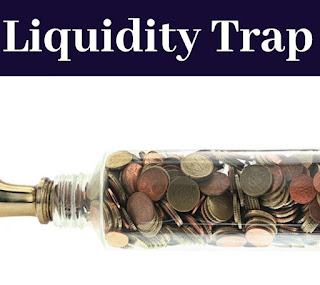A liquidity trap may be a situation, described in Keynesian economics, in which,
"after the speed of interest has fallen to a particular level, liquidity preference may become virtually absolute in
the sense that nearly everyone prefers holding cash instead of holding a debt which yields so low a rate of interest.”
A liquidity trap is caused when people hoard cash
because they expect an adverse event like deflation, insufficient aggregate demand, or war. Among the
characteristics of a liquidity trap are interest rates that are on the brink of zero and changes within the funds that fail to translate into changes within the price level.
In Keynes' description of a liquidity trap, people
simply don't want to carry bonds and like other, non-liquid sorts of money instead. Because of this preference, after converting
bonds into cash, this causes an incidental but significant decrease to the
bonds' prices and a subsequent increase to their yields.
However, people prefer cash regardless of how high these yields are or how high the financial institution sets the bond's rates (yields).
Post-Keynesian economist Hyman Minsky posited that
"after a debt deflation that induces a deep depression, an increase in the
money supply with a fixed head count of other assets may not lead to a rise in
the price of other assets." This naturally causes interest rates on assets
that are not considered "almost perfectly liquid" to rise.

0 comments for "Short Note- Liquidity Trap"